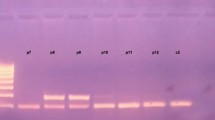Abstract
In testicular descent to the scrotum, a multistep process, many anatomical and hormonal factors play a role. Cryptorchidism occurs in about 1–2% of males and may cause secondary degeneration of the testes. Animal models have shown that abnormalities, in the calcitonin generelated peptide (CgRP) activity, could be relevant in the pathogenesis of cryptorchidism. We performed a mutation screening by PCR exon amplification, single-strand conformation polymorphism (SSCP) and sequencing in four candidate genes, CgRPs (αCgRP, βCgRP), their receptor (CgRPR) and the receptor component protein (CgRP-RCP), in 90 selected cases of idiopathic unilateral or bilateral cryptorchidism. Mutation screening of the coding regions and intron-exon boundaries revealed some polymorphic variants but no pathogenic sequence changes. These preliminary data suggest that these genes are not major factors for cryptorchidism in humans.
Similar content being viewed by others
References
Hutson JM, Terada M, Zhou B, Williams MP. Normal testicular descent and the aetiology of cryptorchidism. Adv Anat Embryol Cell Biol 1996, 132: 1–56.
Hutson JM, Hasthorpe S, Heyns CF. Anatomical and functional aspects of testicular descent and cryptorchidism. Endocr Rev 1997, 18: 259–80.
Foresta C, Ferlin A, Garolla A, Milani C, Oliva G, Rossato M. Functional and cytologic features of the contralateral testis in cryptorchidism. Fertil Steril 1996, 66: 624–9.
Foresta C, Moro E, Garolla A, Onisto M, Ferlin A. Y chromosome microdeletions in cryptorchidism and idiopathic infertility. J Clin Endocrinol Metab 1999, 84: 3660–5.
Przepiorka D, Baylin SB, McBride DW, Testa JR, de Bustros A, Nelkin BD. The human calcitonin gene is located on the short arm of chromosome 11. Biochem Biophys Res Commun 1984, 120: 493–9.
Hrabovszky Z, Farmer PJ, Hutson JM. Undescended testis is accompanied by calcitonin gene related peptide accumulation within the sensory nucleus of the genitofemoral nerve in trans-scrotal rats. J Urol 2001, 165: 1015–8.
Samarakkody UK, Hutson JM. Intrascrotal CGRP 8-37 causes a delay in testicular descent in mice. J Pediatr Surg 1992, 27: 874–5.
Nakazawa I, Nakajima T, Harada H, Ishigami T, Umemura S, Emi M. Human calcitonin receptor-like receptor for adrenomedullin: genomic structure, eight single-nucleotide polymorphisms, and haplotype analysis. J Hum Genet 2001, 46: 132–6.
Foord SM, Craig RK. Isolation and characterisation of a human calcitonin-gene-related-peptide receptor. Eur J Biochem 1987, 170: 373–9.
Evans BN, Rosenblatt MI, Mnayer LO, Oliver KR, Dickerson IM. CGRP-RCP, a novel protein required for signal transduction at calcitonin gene-related peptide and adrenomedullin receptors. J Biol Chem 2000, 275: 31438–43.
Balkan W, Oates EL, Howard GA, Roos BA. Testes exhibit elevated expression of calcitonin gene-related peptide receptor component protein. Endocrinology 1999, 140: 1459–69.
Amara SG, Arriza JL, Leff SE, Swanson LW, Evans RM, Rosenfeld MG. Expression in brain of a messenger RNA encoding a novel neuropeptide homologous to calcitonin gene-related peptide. Science 1985, 229: 1094–7.
Breimer LH, MacIntyre I, Zaidi M. Peptides from the calcitonin genes: molecular genetics, structure and function. Biochem J 1988, 255: 377–90.
World Health Organization. WHO laboratory manual for the examination of human semen and sperm-cervical mucus interaction. Cambridge: Cambridge University Press 1999.
Foresta C, Varotto A, Scandellari C. Assessment of testicular cytology by fine needle aspiration as a diagnostic parameter in the evaluation of the azoospermic subject. Fertil Steril 1992, 57: 858–65.
Ferlin A, Simonato M, Bartoloni L et al. The INSL3-LGR8/ GREAT ligand-receptor pair in human cryptorchidism. J Clin Endocrinol Metab 2003, 88: 4273–9.
Barteczko KJ, Jacob MI. The testicular descent in human. Origin, development and fate of the gubernaculum Hunteri, processus vaginalis peritonei, and gonadal ligaments. Adv Anat Embryol Cell Biol 2000, 156: 1–98.
Author information
Authors and Affiliations
Corresponding author
Rights and permissions
About this article
Cite this article
Zuccarello, D., Morini, E., Douzgou, S. et al. Preliminary data suggest that mutations in the CgRP pathway are not involved in human sporadic cryptorchidism. J Endocrinol Invest 27, 760–764 (2004). https://doi.org/10.1007/BF03347519
Accepted:
Published:
Issue Date:
DOI: https://doi.org/10.1007/BF03347519




